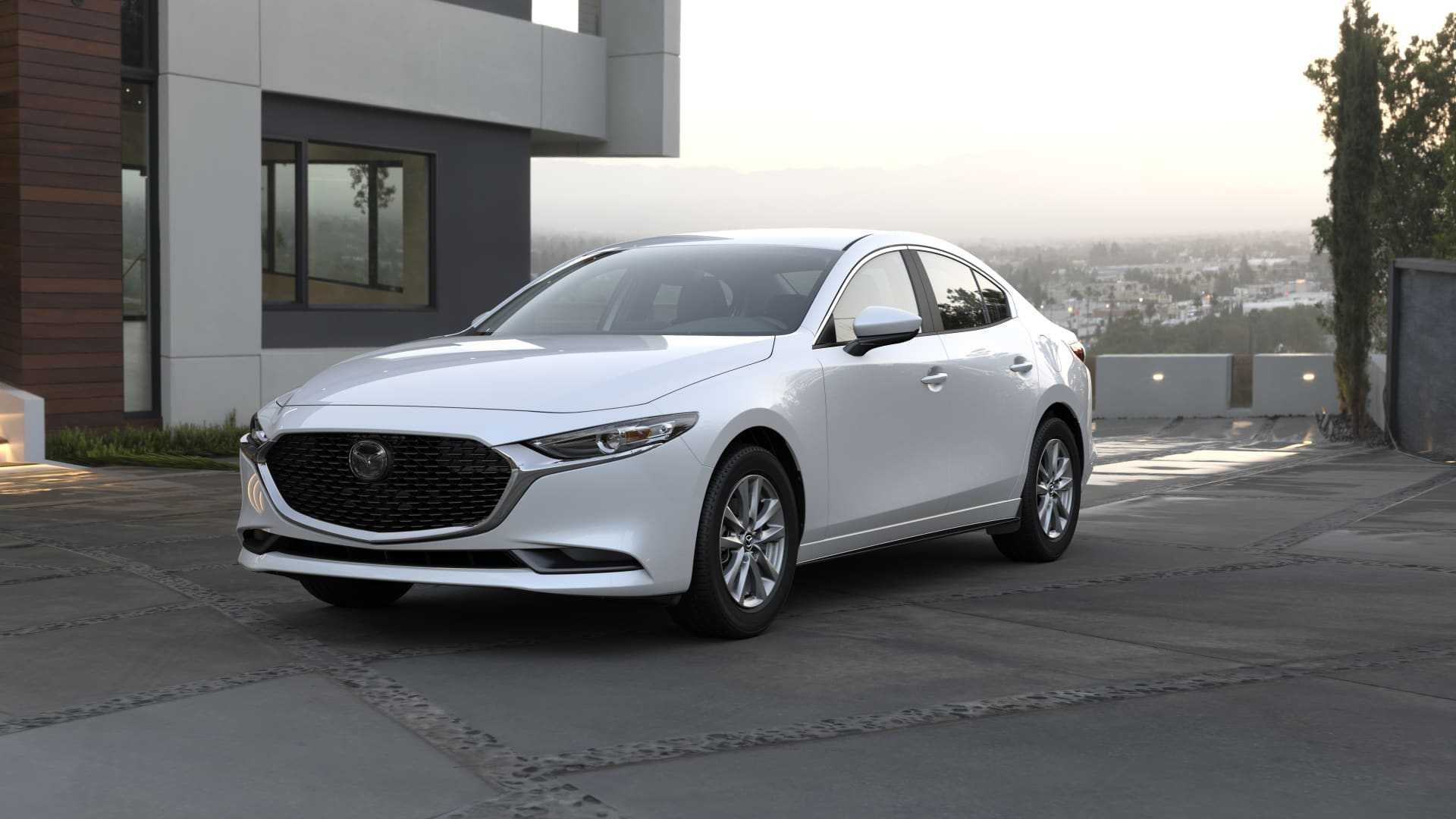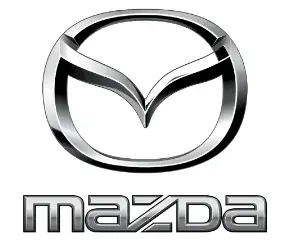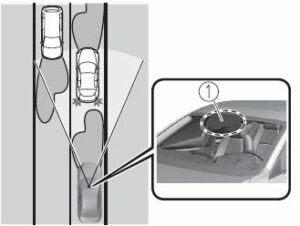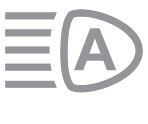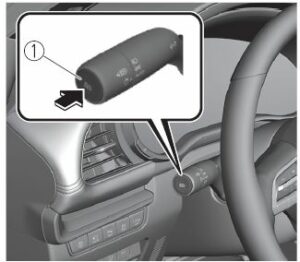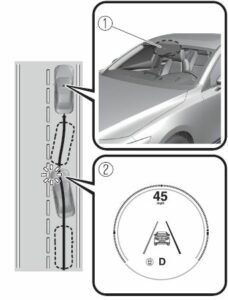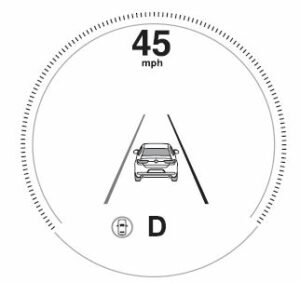Mazda 3 Sedan 2023 i-ACTIVSENSE User Manual
Introduction
The Mazda 3 Sedan 2023 with i-ACTIVSENSE – a vehicle that prioritizes safety and driver assistance technologies to provide a secure and confident driving experience – is now available. Mazda’s i-ACTIVSENSE suite of advanced safety features is intended to help drivers anticipate and avoid potential road hazards, ensuring the safety of both occupants and pedestrians. The Mazda 3 Sedan 2023 incorporates the most recent advancements in automotive safety, including a variety of intelligent technologies that improve situational awareness and risk mitigation. From highways to city streets, i-ACTIVSENSE monitors the environment with sensors and cameras, providing valuable assistance and alerts to keep you and your passengers safe.
i-ACTIVSENSE
i-ACTIVSENSE
i-ACTIVSENSE is a collective term covering a series of advanced safety and driver support systems which make use of cameras and sensors. The systems consist of active safety and pre-crash safety systems.
These systems are designed to assist the driver in safer driving by reducing the load on the driver and helping to avert collisions or reduce their severity. However, because each system has its limitations, always drive carefully and do not rely solely on the systems.
Active Safety Technology
Active Safety Technology supports safer driving by helping the driver to recognize potential hazards and avert accidents.
Driver awareness support systems
Nighttime visibility
Adaptive Front Lighting System (AFS).
High Beam Control System (HBC
Left/right side and rear side detection
Lane Departure Warning System (LDWS)
Blind Spot Monitoring (BSM)
Road sign recognition
Traffic Sign Recognition System (TSR)
Inter-vehicle distance recognition
Distance & Speed Alert (DSA)
Front obstruction detection when approaching a crosswalk
Front Cross Traffic Alert (FCTA)
Rear obstruction detection when
leaving a parking space
Rear Cross Traffic Alert (RCTA)
Full-surround recognition
360° View Monitor
Driver fatigue detection
Driver Attention Alert (DAA)
Driver Monitoring (DM)
Driver support systems
Inter-vehicle distance
Mazda Radar Cruise Control (MRCC)
Mazda Radar Cruise Control with Stop & Go function (MRCC with Stop & Go function)
Lane departure
Lane-keep Assist System (LAS)
Inter-vehicle distance and lane keeping
Traffic Jam Assist (TJA)
Pre-Crash Safety Technology
Pre-crash safety technology is designed to assist the driver in averting collisions or reducing their severity in situations where they cannot be avoided.
Collision damage reduction
Smart Brake Support (SBS)
Camera and Sensors
Forward Sensing Camera (FSC)
The Forward Sensing Camera (FSC) detects lane indications and recognizes headlights, taillights and city lights during nighttime driving. In addition, it also detects the vehicle ahead, pedestrians, or obstructions. The following systems use the Forward Sensing Camera (FSC).
- High Beam Control system (HBC)
Lane Departure Warning System (LDWS)
Traffic Sign Recognition System (TSR)
Distance & Speed Alert (DSA)
Driver Attention Alert (DAA)
Mazda Radar Cruise Control (MRCC)
Mazda Radar Cruise Control with Stop & Go function (MRCC with Stop & Go function)
Lane-keep Assist System (LAS)
Traffic Jam Assist (TJA)
Smart Brake Support (SBS) forward drive detection
The Forward Sensing Camera (FSC) is installed at the top of the windshield near the rearview mirror.
Refer to Forward Sensing Camera (FSC)
Front radar sensor
The front radar sensor detects radio waves reflected off a vehicle ahead sent from the radar sensor. The following systems use the front radar sensor.
- Distance & Speed Alert (DSA)
Mazda Radar Cruise Control
(MRCC)
Mazda Radar Cruise Control with Stop & Go function (MRCC with Stop & Go function)
The front radar sensor is mounted behind the radiator grille.
Refer to Front Radar Sensor
Front side radar sensor
The front side radar sensors detects radio waves reflected off a vehicle ahead sent from the radar sensor. The following systems use the front side radar sensor.
- Front Cross Traffic Alert (FCTA)
The front side radar sensors are installed inside the front bumper, one on the left side and one on the right side.
Refer to Front Side Radar Sensor
- Rear side radar sensor
The rear side radar sensors emit radio waves and detect the radio waves reflected off a vehicle approaching from the rear or an obstruction. The following systems use the rear side radar sensor.
Blind Spot Monitoring (BSM)
- Rear Cross Traffic Alert (RCTA)
Smart Brake Support (SBS) reverse drive detection
The rear side radar sensors are installed inside the rear bumper, one on the left side and one on the right side.
Rear/rear corner ultrasonic sensor
The ultrasonic sensor detects ultrasonic waves reflected off obstructions at the rear sent from the ultrasonic sensors. The following systems use the ultrasonic sensor.
- Smart Brake Support (SBS) reverse drive detection
The ultrasonic sensors are mounted in the rear bumper.
Refer to Rear/Rear corner Ultrasonic Sensor
Front camera/side cameras/rear camera
The front camera, side cameras, and rear camera shoot images of the area surrounding the vehicle. The 360°View Monitor uses each camera. Cameras are installed to the front bumper, door mirrors, and rear bumper.
Refer to Front Camera/Side Cameras/Rear Camera on 4-98 *Some models.
Driver monitoring camera
The driver monitoring camera detects changes in the driver’s facial features and estimates the amount of accumulated fatigue and sleepiness of the driver. The following systems use the driver monitoring camera.
- Driver Monitoring (DM)
The driver monitoring camera is mounted in the center display.
Refer to Driver Monitoring Camera
i-ACTIVSENSE Status Symbol
(Warning/Risk Avoidance Support System)*
The system notifies the driver of any of the following system status using the color or OFF indication of the i-ACTIVSENSE status symbol
(Warning/risk avoidance support system).
- Lane Departure Warning System (LDWS)
Blind Spot Monitoring (BSM)
Distance & Speed Alert (DSA)
Front Cross Traffic Alert (FCTA)
Rear Cross Traffic Alert (RCTA)
Lane-keep Assist System (LAS)
NOTE
The status of the system turned on using the personalization feature is displayed.
i-ACTIVSENSE status symbol
(warning/risk avoidance support system) (white)
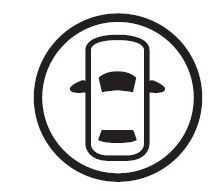
System stand-by status
If none of the systems are activated or if there is a problem with the system, the i-ACTIVSENSE status symbol (warning/risk avoidance support system) (white) is displayed.
NOTE
For example, even when the Blind Spot Monitoring (BSM) is operating normally, if the Lane Departure Warning System (LDWS) has a problem, the i-ACTIVSENSE status symbol (warning/risk avoidance support system) (white) is displayed.
i-ACTIVSENSE status symbol
(warning/risk avoidance support system) (green)

System activated status
If any one of the systems is activated, the i-ACTIVSENSE status symbol
(warning/risk avoidance support system) (green) is displayed.
NOTE
Even if the i-ACTIVSENSE status symbol (warning/risk avoidance support system) (green) is displayed, systems which do not meet the operation conditions will not operate.
i-ACTIVSENSE status symbol
(warning/risk avoidance support system) (amber)
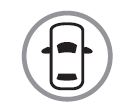
System warning status
If any system warning is activated, the i-ACTIVSENSE status symbol (warning/risk avoidance support system)
(amber) is displayed.
i-ACTIVSENSE OFF symbol (warning/risk avoidance support system)
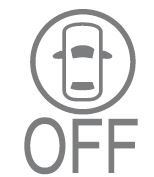
System OFF status
If all the systems are canceled using the personalization features or the
i-ACTIVSENSE OFF switch, the
i-ACTIVSENSE OFF symbol (Warning/risk avoidance support system) is displayed.
i-ACTIVSENSE OFF Switch*
When the i-ACTIVSENSE OFF switch is pressed, the following systems are canceled and the i-ACTIVSENSE OFF symbol (Warning/risk avoidance support system) in the instrument cluster is displayed.
- Lane Departure Warning System (LDWS)
Blind Spot Monitoring (BSM)
Distance & Speed Alert (DSA)
Front Cross Traffic Alert (FCTA)
Rear Cross Traffic Alert (RCTA)
Lane-keep Assist System (LAS) i-ACTIVSENSE OFF switch
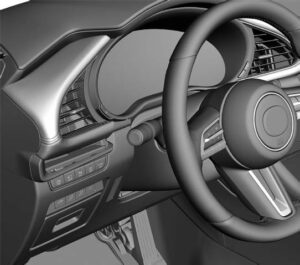
i-ACTIVSENSE OFF symbol (Warning/risk avoidance support system)

If the i-ACTIVSENSE OFF switch is pressed again, the systems return to their original operation status and the i-ACTIVSENSE OFF symbol (Warning/risk avoidance support system) turns off.
If the ignition is switched OFF while you have canceled the systems using the i-ACTIVSENSE OFF switch, the systems are automatically enabled the next time the ignition is switched ON.
However, if the systems are canceled using the personalization features, the systems are not automatically enabled.
NOTE
You can select systems you want to cancel using the personalization features.
Refer to the Settings section in the Mazda Connect Owner’s Manual.
Adaptive Front Lighting System (AFS)*
Adaptive Front Lighting System (AFS)
The adaptive front lighting system
(AFS) automatically adjusts the headlight beams to the left or right in conjunction with the operation of the steering wheel after the headlights have been turned on and the vehicle speed is about 2 km/h (2 mph) or higher.
A system malfunction or operation conditions are indicated by a warning. Refer to Exterior Light Warning Indication/Warning Light
NOTE
The Adaptive Front Lighting System
(AFS) can be switched to on/off using the personalization function.
Refer to the Settings section in the Mazda Connect Owner’s Manual.
High Beam Control System (HBC)*
High Beam Control System (HBC)
The HBC determines the conditions in front of the vehicle using the Forward Sensing Camera (FSC) while driving in darkness to automatically switch the headlights between high and low beams.
Refer to Forward Sensing Camera (FSC)
While driving the vehicle at a speed of about 30 km/h (19 mph) or more, the headlights are switched to high beams when there are no vehicles ahead or approaching in the opposite direction. The system switches the headlights to low beams when one of the following occurs:
- The system detects a vehicle or the headlights/lights of a vehicle approaching in the opposite direction.
The vehicle is driven on roads lined with streetlamps or on roads in well-lit cities and towns.
The vehicle is driven at less than about 20 km/h (12 mph).
The headlight high-beam indicator light turns on while the high beams are on.
- Forward Sensing Camera (FSC)*1
Some models.
*The recognition distance of the Forward Sensing Camera (FSC) varies according to the surrounding conditions.
The warning light turns on when the system has a malfunction.
Refer to High Beam Control System (HBC) Warning Indication/Warning Light (Amber)
CAUTION
- Do not adjust the vehicle height, modify the headlight units, or remove the camera, otherwise the system will not operate normally.
Do not rely excessively on the HBC and drive the vehicle while paying sufficient attention to safety. Switch the headlights between the high beams and low beams manually if necessary.
NOTE
The timing in which the system switches the headlights changes under the following conditions. If the system does not switch the headlights appropriately, manually switch between high and low beams according to the visibility as well as road and traffic conditions.
- When there are sources of light in the area such as streetlamps, illuminated signboards, and traffic signals.
When there are reflective objects in the surrounding area such as reflective plates and signs.
When visibility is reduced under rain, snow and foggy conditions.
When driving on roads with sharp turn or hilly terrain.
When the headlights/rear lamps of vehicles in front of you or in the opposite lane are dim or not illuminated. - When there is insufficient darkness such as at dawn or dusk.
When the trunk/luggage compartment is loaded with heavy objects or the rear passenger seats are occupied.
When visibility is reduced due to a vehicle in front of you spraying water from its tires onto your windshield.
To Operate the System
The HBC operates to switch the headlights automatically between high and low beams after the ignition is switched ON and the headlight switch is in the AUTO and low beam position. The HBC determines that it is dark based on the brightness of the surrounding area. At the same time, the HBC indicator light (green) in the instrument cluster illuminates.
NOTE
Operation of the HBC function can be disabled.
Refer to the Settings section in the Mazda Connect Owner’s Manual.
Manual Switching Switching to low beams
Switch the headlight switch to the position, or press the high beam control switch.
The HBC indicator light (green) turns off.
High beam control switch
If the HBC is turned off using the high beam control switch, press the high beam control switch again to turn the HBC back on.
Switching to high beams
Shift the lever to the high beam position.
The HBC indicator light (green) turns off and the headlight high-beam indicator light is illuminated.
Lane Departure Warning System (LDWS)
Lane Departure Warning System (LDWS)
The LDWS alerts the driver that the vehicle may be deviating from its lane. The system detects the white (yellow) lines on the traffic lane using the forward sensing camera (FSC) and if it determines that the vehicle might be deviating from its lane, it notifies the driver by the LDWS.
Refer to Forward Sensing Camera (FSC)
Use the LDWS when you drive the vehicle on roads with white (yellow) lines.
- Forward sensing camera (FSC)
- Multi-information display
WARNING
Do not rely completely on the LDWS:
- The LDWS system is not designed to compensate for a driver’s lack of caution and relying too much on the system could lead to an accident.
The functions of the LDWS have limitations. Always stay on course using the steering wheel and drive with care.
CAUTION
Heed the following cautions so that the LDWS can operate normally.
- Do not modify the vehicle’s suspensions.
Always use tires of the specified type and size for the front and rear wheels. Consult an Authorized Mazda Dealer for tire replacement.
NOTE
The system may not operate normally under the following conditions.
- The white (yellow) lane lines are less visible because of dirt or paint flaking.
White (yellow) lane lines are less visible because of bad weather (rain, fog, or snow). - The vehicle is driven on a temporary lane or section with a closed lane resulting from construction where there might be multiple white
(yellow) lane lines, or they are interrupted.
The camera picks up an obscure line, such as a temporary line being used for construction, or because of shade, unmelted snow, or grooves filled with water. - The surrounding brightness suddenly changes such as when entering or exiting a tunnel.
- Back-light is reflected off the road surface.
The road surface is wet and shiny after rain, or there are puddles on the road.
The width of a lane is excessively narrow. - The vehicle is driven on roads with tight curves.
Heavy luggage is loaded in the trunk/luggage compartment or on the rear seat causing the vehicle to tilt. - The vehicle is driven through a fork in the road or a junction.
The shade of a guardrail parallel to a white (yellow) lane line is cast on the road.
The illumination of the headlights is weakened because of dirt or the optical axis is deviated at night.
The road is excessively uneven.
The vehicle is shaken after hitting a road bump.
A vehicle in front of your vehicle is running near a white (yellow) lane line making it less visible.
The windshield is dirty or foggy. - Strong light is directed from the front of the vehicle (such as sunlight, or headlights (high-beam) of on-coming vehicles).
- The vehicle is driven through an intersection or a roundabout.
When the System Operates
When the ignition is switched ON, the i-ACTIVSENSE status symbol (warning/risk avoidance support system) (white) turns on and the system goes on standby.
NOTE
If the i-ACTIVSENSE status symbol (warning/risk avoidance support system) (white) does not turn on, the system is canceled using the i-ACTIVSENSE OFF switch or the personalization feature.
Operation conditions
When all of the following conditions are met, the i-ACTIVSENSE status symbol (warning/risk avoidance support system) on the multi-information display changes from white to green and the system becomes operational.
- The ignition is switched ON.
The vehicle speed is about 64 km/h (40 mph) or faster.
The system detects white (yellow) lane lines.
NOTE
When the system does not detect a white (yellow) lane line on one side only, the system does not operate on the side that is not being detected.
When temporarily canceling the system
The LDWS goes on standby in the following cases: The LDWS operation is automatically restored when the system’s operation conditions are met.
- The system cannot detect white (yellow) lane lines.
The vehicle speed is less than about 56 km/h (35 mph).
The turn signal lever is operated.
The accelerator pedal is depressed.
The steering wheel is operated.
The brake pedal is operated.
The function is temporarily stopped.
The LDWS stops functioning in the following cases:
- The temperature in the forward sensing camera (FSC) is too high or too low.
The windshield around the forward sensing camera (FSC) is foggy.
The windshield around the forward sensing camera (FSC) is blocked by an obstruction, causing poor forward visibility.
Strong light (such as sunlight, or headlights (high-beam) of on-coming vehicles) is directed at the forward sensing camera (FSC).
System malfunction
If there is a problem with the system, the i-ACTIVSENSE status symbol
(warning/risk avoidance support system) (white) and the i-ACTIVSENSE warning indication/warning light on the multi-information display turns on and a message is indicated.
Refer to i-ACTIVSENSE Status Symbol (Warning/Risk Avoidance Support System)
LDWS Warning
If the system determines that the vehicle may deviate from its lane, a warning (beep sound, steering wheel vibration) is activated and the direction in which the system determines that the vehicle may deviate is indicated on the multi-information display.
NOTE
- The LDWS settings can be changed. Refer to the Settings section in the Mazda Connect Owner’s Manual.
You may not be able to hear the LDWS warning sound depending on the surrounding conditions such as outside noise.
If you set the LDWS to vibrate the steering wheel, you may not feel the vibrations depending on the road surface conditions.
Canceling the System
The LDWS can be set to inoperable.
- (If only the LDWS is turned off) Refer to the Settings section in the Mazda Connect Owner’s Manual.
(If the LDWS is turned off by operating the i-ACTIVSENSE OFF switch)
Refer to i-ACTIVSENSE OFF Switch
NOTE
If the ignition is switched OFF while you have canceled the system using the i-ACTIVSENSE OFF switch, the system is automatically enabled the next time the ignition is switched ON. However, if the system is canceled using the personalization features, the system is not automatically enabled.
FAQs
Mazda’s i-ACTIVSENSE system is a collection of advanced safety features and driver-assistance technologies designed to improve the driving experience and add safety.
Adaptive cruise control, lane departure warning, lane-keep assist, blind-spot monitoring, rear cross-traffic alert, automatic emergency braking, and pedestrian detection are all included in the i-ACTIVSENSE system.
The i-ACTIVSENSE system is available as an optional package on certain Mazda 3 Sedan 2023 trim levels. It might not be standard on all models, so check with your Mazda dealer.
While individual i-ACTIVSENSE features cannot be customized, you can select the trim level that includes the features you want.
No, the i-ACTIVSENSE system is intended to help the driver but does not take the place of attentive driving. It is critical to maintain constant attention to the road and adhere to safe driving practices.
Yes, most i-ACTIVSENSE features can be turned off or adjusted to your liking. For specific instructions, consult your Mazda dealer or the vehicle’s owner’s manual.
The i-ACTIVSENSE system may be standard on higher trim levels or available as part of an optional package, which may incur additional charges. For pricing information, contact your local Mazda dealer.
The i-ACTIVSENSE system requires no special maintenance. However, for optimal performance, keep the vehicle’s sensors and cameras clean and free of obstructions.
While the i-ACTIVSENSE system can help reduce the risk of accidents, it cannot guarantee that all accidents will be avoided. It is critical to maintain vigilance and drive responsibly.
Retrofitting the i-ACTIVSENSE system to an older Mazda 3 Sedan model may be impractical or prohibitively expensive. For more information, contact your Mazda dealer or authorized service center.
A rearview camera is usually included with the i-ACTIVSENSE system. It contributes to improved visibility when reversing or parking.
The i-ACTIVSENSE system operates within certain parameters and may be dependent on specific road and driving conditions in order to function.
Under certain conditions, such as extreme weather or when the system detects a fault, some i-ACTIVSENSE features, such as adaptive cruise control, may be automatically disabled. This is done to ensure everyone’s safety.
No, the i-ACTIVSENSE system is standard on all Mazda models, including sedans, SUVs, and crossovers. It’s a comprehensive safety suite designed to improve driving in Mazda vehicles.
Useful Links
View Full User Guide: 2023 Mazda 3 Sedan User Manual | Auto User Guide
Download Link: Owner’s – Manuals, Guides, Maintenance Schedules | Mazda USA

